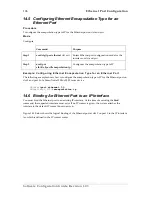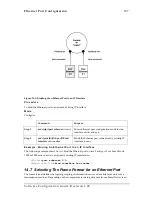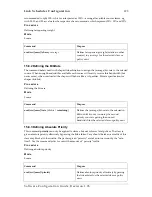
120
Link Scheduler Configuration
Software Configuration Guide, Revision 1.03
3
4
source class
name
share 30
Figure 15-4: Service Policy for Level_1 Arbiter
Parts of the configuration used for arbiter
Low_Priority
are listed below. . The arbitration uses
shaping to share the bandwidth between the two classes Mail and Default. Therefore each class gets
just as much bandwidth as assigned, but never more. The source class Mail gets 40% and Default
gets 60% of the remaining bandwidth as defined for arbiter
Level_1
.
profile service-policy Low_Priority
mode
shaper
source class mail
rate
40
…
source class default
rate
60
Figure 15-5: Service Policy for Low_Priority Arbiter
At last the
Level_1
service policy profile has to be used on the outbound IP interface. As shown in the
example in Figure 15-1 a possible related IP interface could be named as “wan”. Therefore the
interface section in the IP context configuration is as shown in Figure 15-6.
context ip
interface
wan
use profile service-policy Level_1 out
…
Figure 15-6: IP Interface “wan” uses Service Policy Profile
15.7 Creating a Top-Level Service Policy Profile
Each service policy profile defines how the link arbiter has to act as. The link scheduler allows
building up hierarchical scheduling. The uppermost service policy profile, also referred to as top-
level service policy profile, is that service policy profile with which the link arbiter starts performing.
The top-level service policy profile is made up of following components:
•
Arbitration schema definition, like weighted fair queuing or shaping
•
Rate limit definition, that limits the overall output bandwidth on an IP interface
•
Definitions of several source classes or policy, each defining the characteristics of handling a
certain traffic type.
Note:
Be aware that a service policy profiles can include a lower level service policy profile, which is
regarded as a sub-level profile as the example in Figure 15-3 shows. Not all service policy profile
commands can be used to define a sub-level profile, e.g. the commands priority and rate-limit are
only available when defining a top-level service policy profile. Refer to Chapter 15.8, “Specifying
Source Classes or Lower Level Source Policy Profiles”, for more details.
The syntactical structure of a typical top-level service policy profile is listed in Figure 15-7 below. We
will see over the syntax in more detail. To simplify matters the lines of the policy profile listing are
numbered.
1
profile service-policy
name
2
rate-limit
value
mode
mode
Summary of Contents for SmartWare R2.00
Page 2: ......
















































